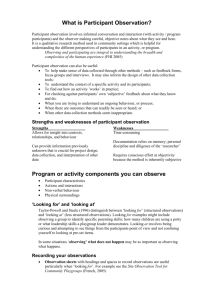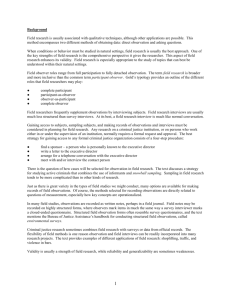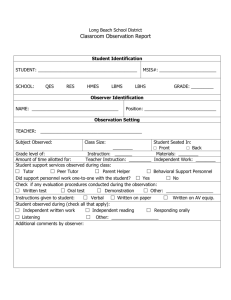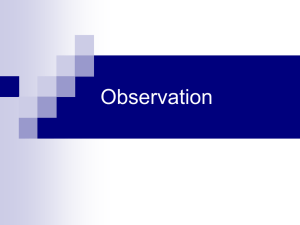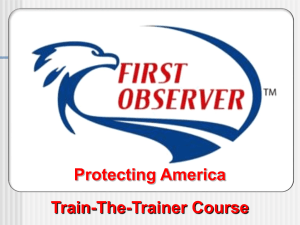OBSERVATION 2 Kinds of observation Participant observation
advertisement
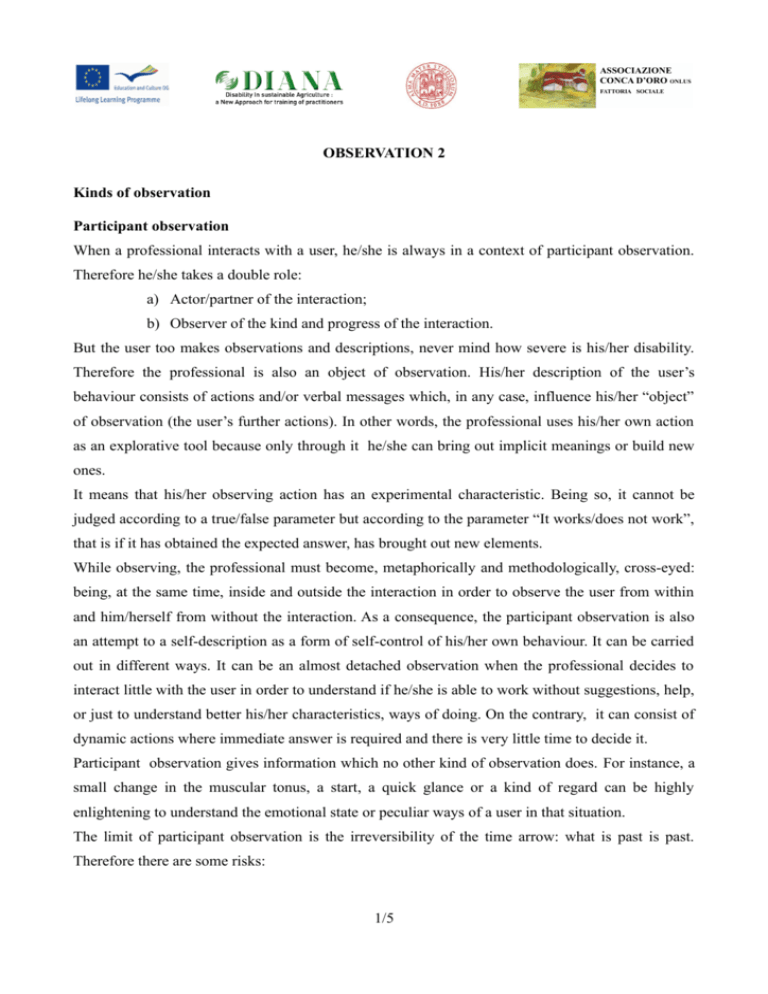
OBSERVATION 2 Kinds of observation Participant observation When a professional interacts with a user, he/she is always in a context of participant observation. Therefore he/she takes a double role: a) Actor/partner of the interaction; b) Observer of the kind and progress of the interaction. But the user too makes observations and descriptions, never mind how severe is his/her disability. Therefore the professional is also an object of observation. His/her description of the user’s behaviour consists of actions and/or verbal messages which, in any case, influence his/her “object” of observation (the user’s further actions). In other words, the professional uses his/her own action as an explorative tool because only through it he/she can bring out implicit meanings or build new ones. It means that his/her observing action has an experimental characteristic. Being so, it cannot be judged according to a true/false parameter but according to the parameter “It works/does not work”, that is if it has obtained the expected answer, has brought out new elements. While observing, the professional must become, metaphorically and methodologically, cross-eyed: being, at the same time, inside and outside the interaction in order to observe the user from within and him/herself from without the interaction. As a consequence, the participant observation is also an attempt to a self-description as a form of self-control of his/her own behaviour. It can be carried out in different ways. It can be an almost detached observation when the professional decides to interact little with the user in order to understand if he/she is able to work without suggestions, help, or just to understand better his/her characteristics, ways of doing. On the contrary, it can consist of dynamic actions where immediate answer is required and there is very little time to decide it. Participant observation gives information which no other kind of observation does. For instance, a small change in the muscular tonus, a start, a quick glance or a kind of regard can be highly enlightening to understand the emotional state or peculiar ways of a user in that situation. The limit of participant observation is the irreversibility of the time arrow: what is past is past. Therefore there are some risks: 1/5 1) an act which could be interesting or meaningful may not be seen or taken into consideration; a) If the professional’s act of observing consists of a practical action or words, it has already influenced the situation and can’t be undone. b) It is difficult to keep under control the unavoidable psychological phenomenons of projection and identification. c) Focusing only some aspects of the interaction or the user’s behaviour, may lead to find what one wants to find. Detached and deferred observation The easy and cheap use of video-camera allows professionals to make a detached and deferred (other time and space) observation of the interaction. It compensates the limits of the participant observation because the videotaped actions and interactions can be observed as many times as one wishes (rewind, slow motion, still frame). The distance in time and space from the videotaped interaction allows the observer to modify his/her own interpretations without influencing the “object” observed. This means that the detached and deferred observation has real projecting and training values The deferred observation is most useful: • At the beginning of the therapeutic, educational or training path when it’s necessary to state general goals and strategies; • During the periodic reviews/controls of the path; • When there are crises or bottlenecks in the user’s evolution, to try to find out causes and/or exit strategies; • For the professionals’ training. Whereas the participant observation is necessarily an individual activity identified with the direct interaction, the deferred observation is necessarily a shared activity because different persons have different perceptive habits, different ways of connecting data. It requires the translation of real actions into words, said or written (“paper words”), because only the language allows the intersubjective discourse, the analysis and control of interpretations. The first and most important difficulty in translating concrete actions into words consists of giving the right name to actions, keeping the descriptions separate from the interpretations. Concerning this, we quote an interesting statement of Ester Bick, founder of Infant Observation: “When we 2/5 must describe the facts observed, we realize that every word is full of implications. Must the observer say the nipple has” gone out” of the baby’s mouth or that it has “slipped” out of it, was “pulled away”, “removed” or has “escaped”? (Bick, 1964). These are not useless semantic nuances because choosing a word or another one means to make different interpretations of the interaction which is going on. The problem can be solved describing the action with more molecular categories, that is the ways of the action. For instance, what is the difference between “pull away” and “remove”? The last one is a neutral term whereas “pull away” may imply strength and speed which belong to the categories of time and muscular tonus. A neutral and shared description of actions and their ways will allow to make useful and complex interpretations, avoiding personal impressions and feelings. We wish to point out that the ways of actions are both the most useful observation tools and the bricks of an interaction’s rules and meanings. For instance, to say that a person is aggressive is not an observational description but just a very generic definition because it carries neither descriptions of behaviours, actions chosen to say so nor of the context in which these actions happen. Moreover it doesn’t suggest any strategies or tools to change the situation. Just another example: let’s observe the gesture of offering an object. It’s an apparently trivial action but it has a significant meaning. Through it the person offering make more valuable the object offered, devote time to the person to whom he/she offer the object, send a message about his/her identity and their relation. But this action hides a problem pointed out by the inverted commas of the verb “offer” because it is an interpretation of an action which should be described as “move an object from a person to another one”. We can accept and share this interpretation if we analyze the way the person offering extends his arms (usually rather slowly), how he/she holds the object, because these are the ways which shape the relational meaning of the action. If he/she doesn’t use the “right” time, the result is a hasty action which cannot be seen as an offer. In the same way, if he/she doesn’t look at the person he/she is giving the object to, the action can’t be an offer because “offer” requires a direct attention to the addressee. If the muscular tonus is high, it will impact on the other one’s instead of meeting it. Also the context in which the action takes place contributes to its meaning (e.g. previous and further actions). The more complex the interpretations are, the more detailed must be the description of actions and their ways. The aims are: 1) Avoid the “cramp” of automatic interpretation which usually is the most trivial one. 2) Transform insights and intuitions into checked and shared information which can be used to 3/5 verify the state of interaction and provide tools/strategies to improve its quality. We said that the deferred observation must be a collective activity in order to be really effective. If observation is an exploration activity which aims at finding and understanding something new, an individual observation runs the risk to find what a person already knows or to look for evidence of what he thinks he knows. On the contrary, a collective observation advances the comparison and integration of different perceptive habits, interpretive paths and the building up of a common descriptive language. The observation of the observer Deferred observation is a also an observation of second degree: It’s not only an observation of the interaction between professional and user or user and user, but at the same time, also an observation of the observers. That is, the elements of the interaction (actions, gaze, posture, time, etc.) that each observer thinks meaningful, important, the ways he/she connects them and the meanings he/she thinks they have. Therefore it’s necessary to: • Multiply the points of view and therefore the different interpretation paths; a) Explore and make explicit the knowledges, know how, theories each observer has referred to in his/her interpretation path. It means to be conscious of the visible and concrete elements on which the observer has based his/her interpretation of the interaction or user’s behaviour. The result is that this kind of observation has an inner training value. The awareness that there are more than one possible interpretation of the same action or interaction can have practical outputs because it can change the quality of a relation or interaction. For instance, it can provide the practical tools to break the selfsupporting vicious circle that often takes between the meaning carried by pathological behaviours and their symptomatic interpretation by the professional. In such a way it is possible to pursue. The final aim of every care relation which is also the answer to an ethic imperative: “always act in such a way to increase the number of possible choices” (von Foerster 1982). In this kind of observation the most difficult task is up to the observer who is also an actor of the observed interaction because he/she has the uncomfortable double role of being, at the same time, observer and “object” of the observing description. “We human beings feel very much un easy when somebody starts interpreting our behaviours translating the minto words concerning the relationship. We prefer very much that our messages about thi aspect remain analogical, unconscious and unintentional” (Bateson 1972). 4/5 He/she has to communicate his/her interpretation as participant to the observed interaction: e.g. “I did so an so because I wanted that…”, “I thought that he wasn’t able to...”. Moreover he/she has to compare his/her interpretations as participant observer and those as detached observer, to point out accordances and differences. And last, but not the least, to allow the comparison between his/her interpretations and his/her partners’. In order that deferred observation and observation of observer may be a useful training tool, providing useful information about professional and user’s relation, the state of therapeutic or educational path, successful strategies, etc, two conditions must be met: a) A “gentleman’s agreement” among the professionals b) The progressive building up of a shared descriptive language. “Gentleman agreement” means that the various descriptions and interpretations must not be a judgment on the colleague’s actions and choices (right/wrong, good/bad). In order to achieve this, the descriptive language should be as denotative and neutral as possible. For instance, to say that an action is “fast” or “hurried “carries very different meanings. The first one is a neutral description, the second one implies a judgement on its author A shared descriptive language means that observers agree to use the same concrete and “visible” words to describe an action or an interaction. On the basis of a shared description it’s possible to put forward and compare different interpretations. This is a strong training tool because it “obliges” each professional to bring to conscience and explain why he/she has connected the descriptive elements in such a way while others have connected them in a different way (self awareness: a training need stated in Krakow). And then compare his/her own interaction style with others’, trying to understand which one is more effective with Karl and which one with Antonio (mutual learning and adaptation to the need: other training needs stated in Krakow.). Bibliographic References Bateson Gregory, Steps to an ecology of mind Bick Esther, Notes on infant observation in psychoanalytic training , Von Foerster Heinz, Observing systems Hinde Robert, Towards understanding relationships World Health Organization, International Classification of Functioning, Disability and Health 5/5


